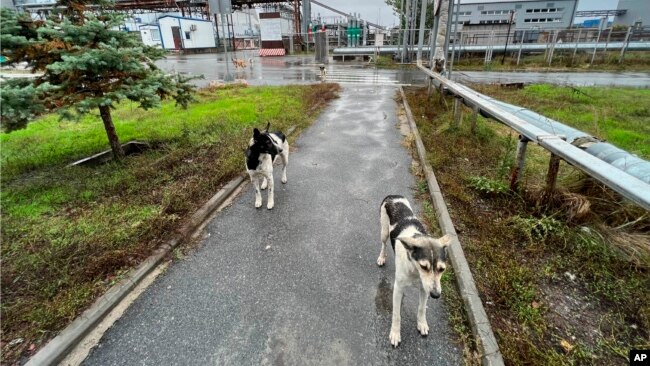今、犬からチェルノブイリに学ぶこととは
どうやって生き延びたのでしょう?
どのような我々が学ぶべきこと、今後へ備えるべき鍵があるのでしょうか?
VOAで英語を学びましょう!!
チェルノブイリの被災犬は人間に新しい秘訣を教えられるか?
Can the Survivor Dogs of Chernobyl Teach Humans New Tricks?
2023、March,13 learningenglish.voanews.com
世界最悪の原発事故から35年以上、ウクライナ・チェルノブイリの犬たちは、閉鎖された核センターとその周辺の空きビルで暮らしています。彼らは食べ物を探し、交尾し、生き延び続けています。
科学者たちは、この犬たちを研究することで、厳しく難しい環境下で生きるための新しい方法を人間に教えることができると期待しています。
研究者たちは、最近、雑誌Science Advancesに遺伝学的研究を発表しました。この研究は、政府が指定した被災地周辺の”立ち入り禁止区域”に住む犬302匹を中心に行われました。この地域は、危険なほど高いレベルの放射線が存在します。
科学者たちは、異なるレベルの放射線を受けた犬の集団を特定しました。その結果、これらの犬集団の間に、互いに、また世界の他の地域の犬とも異なる遺伝的な違いがあることが判明しました。
国立ヒトゲノム研究所の遺伝学専門家エレイン・オストランダー氏は、この研究の研究者の一人です。彼女は、科学者たちは、重要な疑問の答えとなる状況を調べる絶好の機会を得たと語っています。「このような過酷な環境で、15世代も生き残るにはどうしたらよいのでしょうか?」
ティム・ムソー氏は、サウスカロライナ大学の生物科学教授で、研究チームの一員です。彼は、この犬が”このような環境が哺乳類に与える影響を調べるための信じられないようなツールを提供してくれる”と話します。
チェルノブイリの環境は熾烈です。1986年4月26日、ウクライナの発電所で爆発と火災が発生し、大量の放射能が大気中に放出されました。30人の作業員が即死しました。その後の放射能による死者は数千人に上ると推定されています。
研究者らは、彼らが研究している犬のほとんどは、飼い主が危険から逃れたときに残された家庭犬と先祖のつながりがあると言います。
ムソー氏は、1990年代後半からチェルノブイリ地域で活動しています。彼は2017年ごろから犬たちの血液を集め始めました。犬の中には、発電所内に住んでいるものもいます。その他は15キロメートルや45キロメートルほど離れた場所にいます。
当初、オストランダー氏は、犬たちは長い時間をかけて密接に交配したため、ほとんど同じになるのではないかと考えたと言いました。しかし、遺伝子を調べたところ、犬たちは放射線量の低いところ、中間のところ、高いところと、それぞれ異なる地域に住んでいることがわかりました。
これは大きな発見でした。オストランダー博士は、この研究により、約15の異なる犬グループの家族を特定することができたと言います。
これで、研究者たちは、グループ間の遺伝子構造の変化を調べ始めることができます。
「我々はそれらを比較することができ、こう言えます:DNAレベルで何が違うのか、何が変わったのか、何が変異したのか、何が進化したのか、何があなたを助け、何があなたを傷つけるのか......。」とオストランダー氏は言います。
科学者たちは、この研究は幅広い用途に使えると述べています。この研究は、”継続的な環境” 攻撃を受けている地域や、宇宙空間の高放射線環境において、動物や人間が現在および将来にわたってどのように生きていくことができるかを示すことができるでしょう。
カリ・エケンシュテット氏は、インディアナ州のパデュー大学の動物医で教授ですが、この研究には関与していません。彼女は、この研究は、高レベルの放射線が大型哺乳類にどのような影響を与えるかについての重要な疑問に答えるための第一歩であると述べています。例えば、「彼らのゲノムを急激な速度で変化させるのか?」と彼女は言います。
科学者たちはすでに追加研究に着手しています。キエフから約100キロ離れた地域で、犬たちと一緒に過ごす時間を多く求めるでしょう。ムソー氏は、昨年10月、チームメートとともに現地に赴きましたが、戦争行為は見られなかったと言います。ムソー氏は、チームは何匹かの犬と親しくなった、と言っています。
「野生であっても、人とのふれあいをとても楽しんでいます。」と彼は言います。「特に食べ物が絡むとね。」
Can the Survivor Dogs of Chernobyl Teach Humans New Tricks?
More than 35 years after the world's worst nuclear accident, the dogs of Chernobyl, Ukraine, live among empty buildings in and around the closed nuclear center. The animals continue to find food, mate and survive.
Scientists hope that studying the dogs can teach humans about new ways to live in severely difficult, unforgiving environments.
The researchers published a genetics study recently in the magazine Science Advances. It centers on 302 dogs living in a government identified “exclusion zone” around the area of the disaster. The area has dangerously high levels of radiation.
The scientists identified dog populations that received different levels of radiation. The research found genetic differences among the dog groups that make them different from one another and other dogs in other parts of the world.
Genetics expert Elaine Ostrander with the National Human Genome Research Institute is one of the study investigators. She said the scientists had a great chance to examine a situation that could help answer an important question: “How do you survive in a hostile environment like this for 15 generations?”
Tim Mousseau is a professor of biological sciences at the University of South Carolina and a member of the study team. He said the dogs “provide an incredible tool to look at the impacts of this kind of a setting” on mammals.
Chernobyl’s environment is fierce. On April 26, 1986, an explosion and fire at the Ukraine power plant released huge amounts of radioactivity into the atmosphere. Thirty workers were killed immediately. Later deaths from radiation poisoning are estimated to be in the thousands.
Researchers said most of the dogs they are studying appear to have ancestral ties to family dogs left behind when their owners fled the danger.
Mousseau has been working in the Chernobyl area since the late 1990s. He began collecting blood from the dogs around 2017. Some of the dogs live in the power plant. Others are about 15 kilometers or 45 kilometers away.
At first, Ostrander said, the team thought the dogs might have mated so closely over time that they would be much the same. But the testing of their genes showed that the dogs lived in areas of different radiation levels – low, middle and high.
It was a major finding. Ostrander said the scientists could identify families” of about 15 different dog groups.
Now researchers can begin to look for changes in genetic structures among the groups.
“We can compare them and we can say: OK, what’s different, what’s changed, what’s mutated, what’s evolved, what helps you, what hurts you at the DNA level?” Ostrander said.
Scientists said the research could have wide uses. It could show how animals and humans can live now and in the future in areas under “continuous environmental” attack and in the high-radiation environment of space.
Kari Ekenstedt is an animal doctor and professor at Purdue University in Indiana who was not involved in the study. She said the study is a first step toward answering important questions about how higher level radiation affects large mammals. For example, she said, “Is it going to be changing their genomes at a rapid rate?”
Scientists have already started on additional research. It will require more time with the dogs in the area about 100 kilometers from Kyiv. Mousseau said he and his teammates were there most recently last October and did not see any war activity. Mousseau said the team has grown close to some dogs
“Even though they’re wild, they still very much enjoy human interaction," he said, “Especially when there’s food involved.”
Words in This Story
exclusion zone –n. an area that people are prevented from entering for safety or other reasons
incredible –adj. difficult to believe; extremely good
impact –n. the results of an event or condition
mammal –n. a kind of animal that has hair, certain ear bones and feeds milk to its young
mutated –adj. changes into another form
rapid –adj. fast; happening or moving quickly

